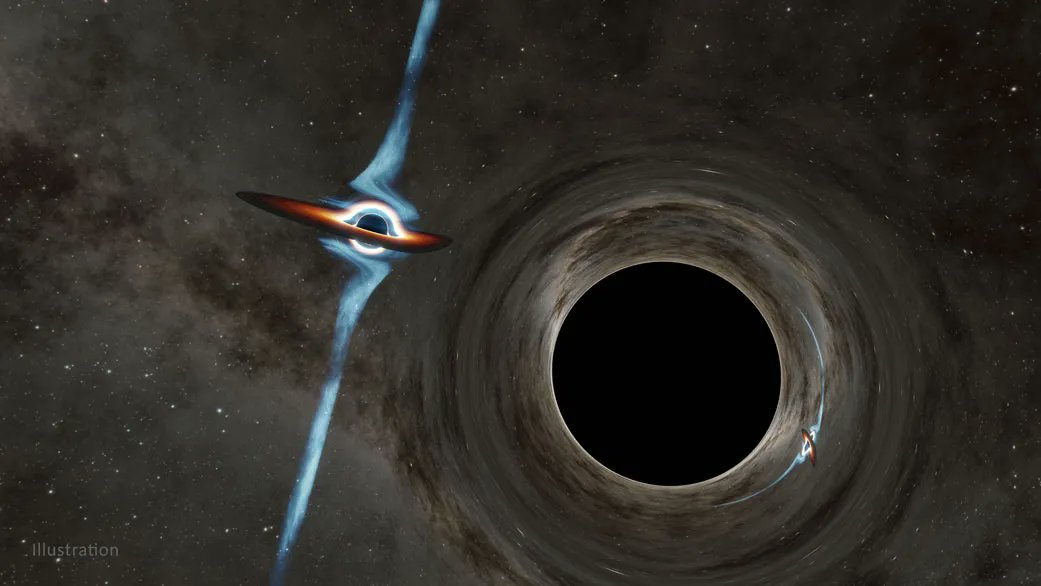The thing with black holes is they’re hard to see. Typically we can only detect their presence when we can detect their gravitational pull. And if there are rogue black holes simply traveling throughout the galaxy and not tied to another luminous astronomical, it would be fiendishly hard to detect them. But now we have a new potential data set to do so.
Gaia just released its massive 3rd data set that contains astrometry data for over 1.5 billion stars, about 1% of the total number of stars in the galaxy. According to a new paper by Jeff Andrews of the University of Florida and Northwestern University, it might be possible for Gaia to detect perturbances caused by a rogue black hole briefly interacting with one of the 1.5 billion stars in the catalog. Unfortunately, it’s just not very likely that any such interaction actually took place during Gaia’s observing time.
This paper is the third in a series that explores potentially using the trove of new Gaia data to find companions to some of its stars. Luminous stars are Gaia’s specialty, but many have “dark companions” that are not as detectable as their light-emitting partners. Not all of these dark companions are black holes – some might be dead stars that have already burnt through their fuel supply but weren’t massive enough to form a black hole.
The first paper looked at how scientists could use Gaia’s data to pick up on signatures of those dark companions. The second focused on whether the data contains hints of very long binary orbital relationships with orbital periods that outlast the observational timeline. Both of those studies point to valid analyses that someone will undoubtedly undertake now that the Gaia data is released. However, they don’t address what is potentially the most interesting of all dark companions – black holes.
Estimates put the number of black holes in the Milky Way at between 10 million and 1 billion, between .01% and 1% of the probable total number of stars in the galaxy. But most of these are only the size of a star and extremely hard to detect using conventional data. Their pull might just be noticeable in Gaia’s data set, though.
Gaia itself collects astrometry data, which detects the position, motions, and magnitudes of stars. Any interaction, however fleeting, with a black hole, could potentially affect any of these metrics. It’s just a matter of understanding what to look for.
That might not be so easy, as the complex math and “extreme assumptions” that the Andrews papers details make clear. He notes that about 300,000 stars in Gaia’s catalog are exhibiting acceleration events. However, he also notes that, with some very blanket assumptions about the dark matter content of the Milky Way, none of those 300,000 observed accelerations are likely due to interactions with a rogue black hole.
But that doesn’t mean it isn’t possible to detect any such interaction with Gaia. In fact, Andrews believes that it is possible, with some more assumptions about how the galaxy itself is structured. A rogue black hole transiently interacting with a luminous star is just a rare event that most likely Gaia didn’t capture it during its observational period. But if another scientist does find evidence of such an interaction hiding in the data or another mission further in the future manages to capture proof of it, such a discovery would be a boon for black hole science.
Learn More:
Jeff Andrews – Weighing the Darkness III: How Gaia Could, but Probably Won’t, Astrometrically Detect Free-Floating Black Holes
UT – The First Rogue Black Hole has Been Discovered, and it’s Only 5,000 Light-Years Away
UT – Hubble Pins Down the Mass of a Potential Free-Floating Black Hole That’s 5,000 Light-Years Away
ScienceAlert – Rogue ‘Missing Link’ Black Holes Could Be Zooming Around The Universe as We Speak
Lead Image:
Illustration of a black hole collision.
Credit – Caltech-IPAC


That is a very compelling illustration.